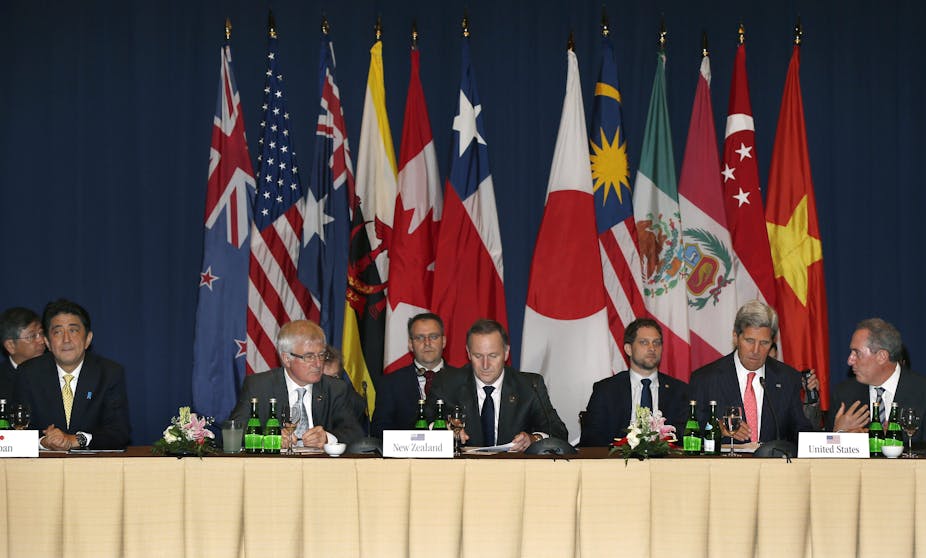Expect to hear a lot about the Trans Pacific Partnership in the next few days. As it moves into final stages of negotiations, outrage over some of its more onerous provisions is ramping up around the world.
From tomorrow, trade ministers from 12 countries will meet in Singapore to hammer out some difficult issues that have plagued the controversial agreement’s negotiations for the last three years. I will be providing updates to this article as the meeting progresses.
The controversy surrounding the negotiations stems from widespread concern about the lack of transparency in the negotiations, as well as the number of highly politically sensitive issues on the table.
These concerns came to a head in Australia this week when the Senate issued an order for the release of the agreement’s text before it’s signed by Cabinet.
The Australian consumer organisation Choice has launched a petition seeking the public release of the text. And the Australian Fair Trade and Investment Network has also raised an alarm.
As things heat up over in Singapore and the Senate prepares for a political stoush over the order for disclosure, here’s what you need to know to make sense of it all.
How it’s going
The Trans Pacific Partnership has its origins in a relatively insignificant free trade agreement between Brunei, New Zealand, Chile and Singapore, known as the Pacific 4 or simply P4. This pact suddenly assumed greater significance in 2008, when the United States and several other countries expressed an interest in joining.
In March 2010, negotiations for the Trans Pacific Partnership began with the United States, Australia, Peru and Vietnam joining the original P4 members. Over time, these eight countries were also joined by Malaysia, Canada, Mexico and most recently, Japan.
The pact will cover almost 40% of global GDP and over 25% of world trade. Like most free trade agreements, the negotiations take place under conditions of confidentiality. But this agreement has been heavily criticised for unprecedented levels of secrecy.
What we do know is that it consists of around 29 chapters or negotiating areas. Some chapters have annexes that relate to specific goods such as pharmaceuticals, or wine and spirits. Amazingly, there is no complete publicly available list of chapters and annexes.
It includes not only traditional trade issues, such as the movement of goods and services, but also many policy areas that previously have been matters for domestic policy making rather than trade negotiations. It touches on many issues with a public interest dimension, such as drug and other patents, copyright and the internet.
But the public has no access to its draft text, and little opportunity for input. Most of what we know about it comes from leaks of negotiating documents, most recently a consolidated draft of the intellectual property chapter, leaked by Wikileaks on 13 November.

The documents show deep rifts among the negotiating countries, with the United States pushing provisions that, in many areas, are not in the interests of other countries.
The bulk of the legal text of the agreement has been negotiated over 19 formal rounds. The last was held in Brunei in August.
The countries involved have signed an agreement to keep the text confidential until after negotiations have concluded and the agreement has been signed. And to keep negotiating documents secret until four years after the agreement is concluded or the negotiations are abandoned.
There are some opportunities for stakeholders, such as health and consumer representatives to put their views to the trade negotiators through official stakeholder events at negotiating rounds. Or through domestic consultation processes, such as briefings held by Australia’s Department of Foreign Affairs and Trade.
But since those being consulted don’t have much information about what’s in the agreement and aren’t permitted to view the text, meaningful input is difficult. Indeed, it’s farcical to be consulted about the details of text you haven’t seen!
Why there’s cause for concern
Many of the issues being negotiated have long-term ramifications for health, the environment, and other areas of public policy. But it’s very difficult for even those who have been closely following the negotiations to work out what the likely outcomes on these issues will be because the process is so secret.
Some of the key concerns centre on health and medicines. The humanitarian organisation Medecins Sans Frontieres has warned that the Trans Pacific Partnership could become:
the most harmful trade pact ever for access to medicines in developing countries.
Another area of concern is the inclusion of an investor-state dispute settlement clause in the agreement. The Australian government recently indicated it is prepared to accept this, even though such clauses allow foreign corporations to sue a government if its policies and laws are deemed to affect corporate investments.
Philip Morris Asia is currently suing the Australian government over the tobacco plain packaging laws, using this very mechanism from a treaty between Hong Kong and Australia.
Public health and consumer organisations worry that including an investor-state dispute settlement clause in the Trans Pacific Partnership will open the gates to more such lawsuits over public health measures.
At the (probably) final meeting for the Trans Pacific Partnership negotiations this weekend, trade ministers are expected to make difficult political compromises to meet their self-imposed deadline to conclude talks before the end of the year.
We don’t know what compromises the governments are considering, but there’s clearly reason to be concerned.

